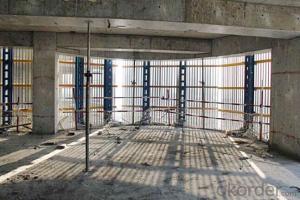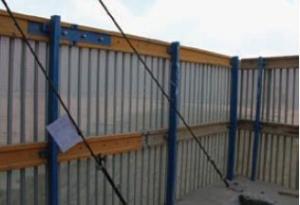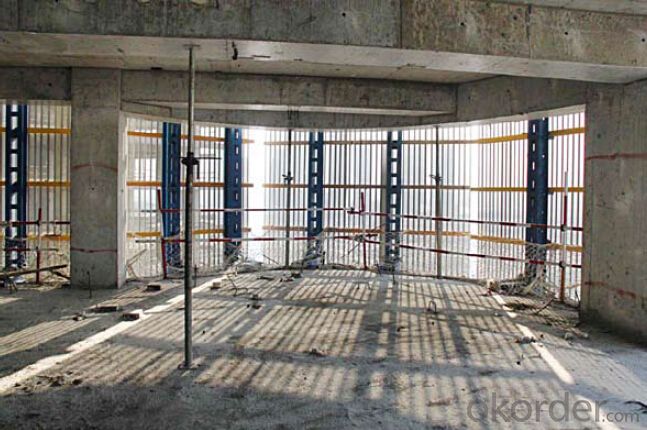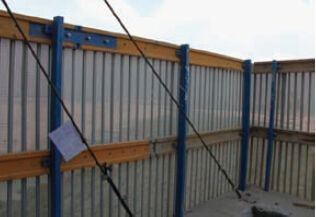Protection Platform for Formwork and Scaffolding Build
- Loading Port:
- Tianjin
- Payment Terms:
- TT OR LC
- Min Order Qty:
- 50 m²
- Supply Capability:
- 1000 m²/month
OKorder Service Pledge
OKorder Financial Service
You Might Also Like
Protection Platform PP-50
A kind of new type construction protection system, applying operating platform and safer job
location for construction corps.
Characteristics:
◆ Easy and quick assembling.
◆ Lifted as a group, it is rapid and economic.
◆ Auto-climbing
◆ A safe and reliable anchor system
1. Composition
2. Assembly process of anchor system
(1) Embed V-climbing cone and anchor plate into the slab.
(2) Fix anchor shoe on the slab by tensile bolt.
(3) The fixed anchor shoe.
◆ High work efficiency with work platform and unload platform
◆ High light transmittance with the hollow block
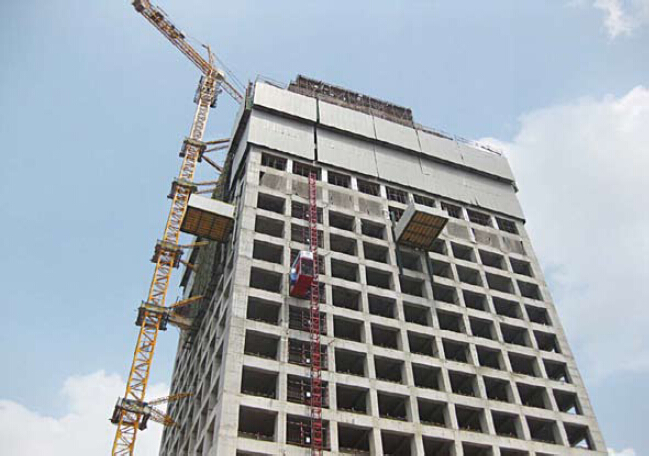
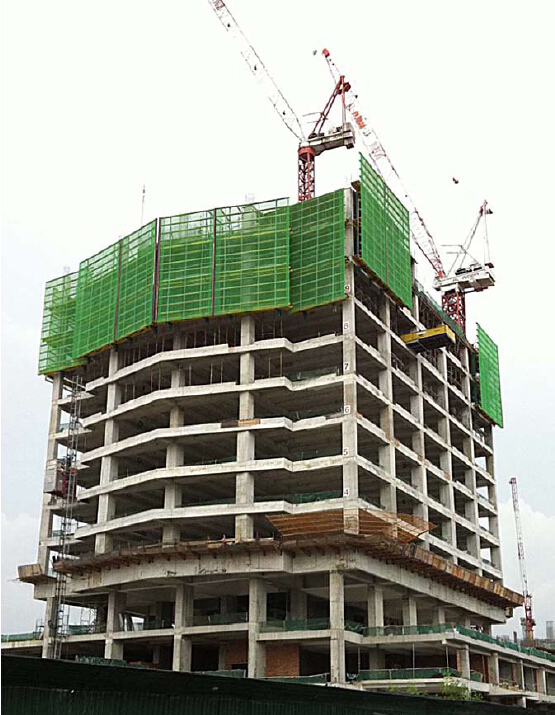
- Q: What are the considerations when designing steel formwork for swimming pools?
- When designing steel formwork for swimming pools, there are several key considerations that need to be taken into account. Firstly, the structural strength of the formwork is crucial as it needs to withstand the weight of the concrete and the water pressure once the pool is filled. The formwork should be made of high-quality steel that is able to support these loads without any deformation or failure. Additionally, the design should ensure proper alignment and support to achieve the desired shape and dimensions of the swimming pool. Attention should be given to the corners, curves, and transitions to ensure smooth and even concrete placement. The formwork should also allow for easy and efficient installation and removal. Considering the time and labor involved in constructing a swimming pool, a well-designed formwork system can greatly streamline the process and save on costs. Modular or adjustable formwork systems can be beneficial in this regard. Furthermore, the formwork should be able to withstand the chemical exposure from the pool water and any necessary maintenance or repairs. It should be resistant to corrosion and have a long lifespan to avoid frequent replacements. Lastly, safety measures should be incorporated into the design to protect workers during the construction phase. This can include features like sturdy handrails, non-slip surfaces, and proper access points. Overall, designing steel formwork for swimming pools requires careful consideration of structural integrity, ease of installation, durability, and safety to ensure a successful and long-lasting construction project.
- Q: Can steel formwork be used for curved or complex structures?
- Yes, steel formwork can be used for curved or complex structures. Steel formwork offers a high level of flexibility and versatility, making it suitable for creating various shapes and designs. Its strength and rigidity allow it to hold its shape, even when used for curved or intricate structures. Additionally, steel formwork can be easily fabricated and adjusted to meet specific project requirements, making it an ideal choice for constructing complex designs.
- Q: Can steel formwork be used in residential housing projects?
- Yes, steel formwork can be used in residential housing projects. Steel formwork is a versatile and durable option for construction, offering strength and stability to the structure. It allows for precise and efficient shaping of concrete, ensuring high-quality finishes in residential buildings. Additionally, steel formwork can be reused multiple times, making it a cost-effective choice for long-term projects.
- Q: How does steel formwork handle surface imperfections in concrete?
- Steel formwork is commonly used in construction projects to create temporary molds for pouring concrete. One of the advantages of steel formwork is its ability to handle surface imperfections in concrete effectively. The smooth and rigid nature of steel formwork allows for a precise and controlled placement of concrete, minimizing the occurrence of surface imperfections. Unlike other materials such as wood or plywood, steel formwork does not flex or warp, ensuring a consistent surface finish. In cases where surface imperfections do occur, steel formwork provides a solid foundation to address these issues. The strength and durability of steel enable it to withstand the pressure exerted by the concrete, preventing bulges or deformations that could result in surface imperfections. Furthermore, steel formwork can be easily adjusted or modified to accommodate any irregularities or unevenness in the concrete. This flexibility allows for the correction of minor imperfections during the pouring process, resulting in a smoother and more even surface finish. Additionally, steel formwork can be treated or coated to prevent sticking or bonding between the concrete and the formwork. This coating reduces the likelihood of surface imperfections caused by the concrete adhering to the formwork. Overall, steel formwork is a reliable and efficient solution for handling surface imperfections in concrete. Its strength, rigidity, and versatility enable construction professionals to achieve a high-quality finish, even in challenging conditions.
- Q: What are the considerations when designing steel formwork for retaining structures?
- When designing steel formwork for retaining structures, there are several important considerations that need to be taken into account. Firstly, the structural stability of the formwork needs to be ensured, as it will be subjected to significant loads and pressures from the weight of the concrete and the earth it is retaining. The formwork needs to be designed to withstand these loads without deformation or failure. Additionally, the formwork should be easy to assemble, disassemble, and adjust. This is important for efficiency during construction and for future maintenance or repairs if needed. The design should allow for quick and easy installation of the formwork system. Another consideration is the durability of the formwork. Steel formwork should be resistant to corrosion, as it will be exposed to moisture from the concrete. Proper surface treatment and protective coatings should be applied to ensure its longevity. Furthermore, the formwork should be designed to provide a smooth and consistent finish to the concrete. This is important for the aesthetic appearance of the retaining structure and for ensuring the desired structural integrity. Lastly, cost-effectiveness is an important consideration. The design of the steel formwork should aim to minimize material usage and labor costs, while still meeting the required performance and safety standards. Overall, when designing steel formwork for retaining structures, the considerations include structural stability, ease of assembly and adjustment, durability, concrete finish quality, and cost-effectiveness.
- Q: What are the different types of formwork bracing used with steel formwork?
- Steel formwork can be supported and stabilized using various types of bracing. These include: 1. Horizontal Bracing: Installed between vertical supports, this bracing provides stability and prevents lateral movement or deformation of the formwork. 2. Diagonal Bracing: By connecting vertical supports diagonally, this bracing adds stability, evenly distributes the load, and prevents twisting or buckling of the formwork. 3. Vertical Bracing: Installed between horizontal supports, this bracing supports the vertical members of the formwork system and prevents vertical movement or deformation. 4. Cross Bracing: This bracing combines horizontal and diagonal support, providing both lateral and diagonal stability. It is commonly used in larger structures or when increased stability is required. 5. Tie Rods: These rods connect the formwork panels and offer additional support. They are placed at regular intervals along the formwork and tightened to ensure that the formwork remains in place during concrete pouring. The selection of formwork bracing depends on project-specific requirements, such as the size and complexity of the structure, as well as the load-bearing capacity of the formwork system. It is crucial to design and install the bracing carefully to ensure the safety and stability of the formwork during construction.
- Q: What is steel formwork?
- In construction, steel formwork is employed as a temporary structure or mold to mold and support concrete until it solidifies and becomes firm. It comprises welded steel sheets or plates that are assembled to create a framework. This framework is then utilized to secure the poured and compacted concrete in place. Steel formwork is renowned for its resilience, strength, and ability to withstand the pressure exerted by moist concrete. It is frequently utilized in extensive construction endeavors, such as skyscrapers, bridges, and tunnels, where the concrete necessitates intricate and precise shaping. Steel formwork can be easily put together and taken apart, making it both reusable and cost-efficient. Additionally, it provides a smooth and consistent finish to the concrete surface, resulting in a superior end product. In summary, steel formwork is an indispensable instrument in contemporary construction that aids in the efficient and effective construction of concrete structures.
- Q: How does steel formwork handle different concrete surface treatments?
- Steel formwork is highly versatile and can handle different concrete surface treatments effectively. The smooth and rigid nature of steel formwork allows for the application of various surface treatments, such as textured finishes, exposed aggregate, or decorative patterns, without compromising the quality or integrity of the concrete. Steel formwork provides a stable and durable framework that ensures the desired surface treatment remains intact during the concrete pouring and curing process. Furthermore, the reusability of steel formwork allows for consistent and reliable results across multiple projects with different concrete surface treatments.
- Q: Can steel formwork be used for structures with high fire resistance requirements?
- Yes, steel formwork can be used for structures with high fire resistance requirements. Steel is known for its excellent fire resistance properties, as it does not burn or contribute to the spread of fire. Steel formwork can withstand high temperatures and maintain its structural integrity, making it suitable for use in fire-resistant structures.
- Q: How does steel formwork affect the concrete pouring process?
- Steel formwork plays a crucial role in the concrete pouring process by providing a sturdy and reliable support structure for the wet concrete. It offers several advantages over other types of formwork, such as timber or plastic. Firstly, steel formwork is highly durable and can withstand the pressure exerted by the wet concrete without warping or deforming. This ensures that the formwork maintains its shape and dimensions, resulting in a finished concrete structure that is accurate and precise. This is particularly important for projects with complex shapes or intricate designs. Additionally, steel formwork is reusable, making it a cost-effective solution for construction projects. Unlike timber or plastic formwork, steel can be used multiple times, reducing the overall project expenses. It also contributes to sustainability by minimizing waste and reducing the environmental impact associated with disposable formwork materials. Another advantage of steel formwork is its ability to provide a smooth surface finish to the concrete. The steel panels are manufactured with high precision, resulting in a uniform and even surface texture on the poured concrete. This is particularly beneficial for projects that require a high-quality finish, such as architectural structures or exposed concrete surfaces. Furthermore, steel formwork offers excellent stability and support during the pouring process. Its rigid structure prevents any movement or shifting of the formwork, ensuring that the concrete is poured accurately and evenly. This is crucial for maintaining the structural integrity of the concrete and preventing any potential defects or weaknesses. In summary, steel formwork significantly affects the concrete pouring process by providing durability, reusability, smooth surface finish, and stability. It ensures that the concrete structure is formed accurately and precisely, resulting in a high-quality finished product.
Send your message to us
Protection Platform for Formwork and Scaffolding Build
- Loading Port:
- Tianjin
- Payment Terms:
- TT OR LC
- Min Order Qty:
- 50 m²
- Supply Capability:
- 1000 m²/month
OKorder Service Pledge
OKorder Financial Service
Similar products
Hot products
Hot Searches
Related keywords
